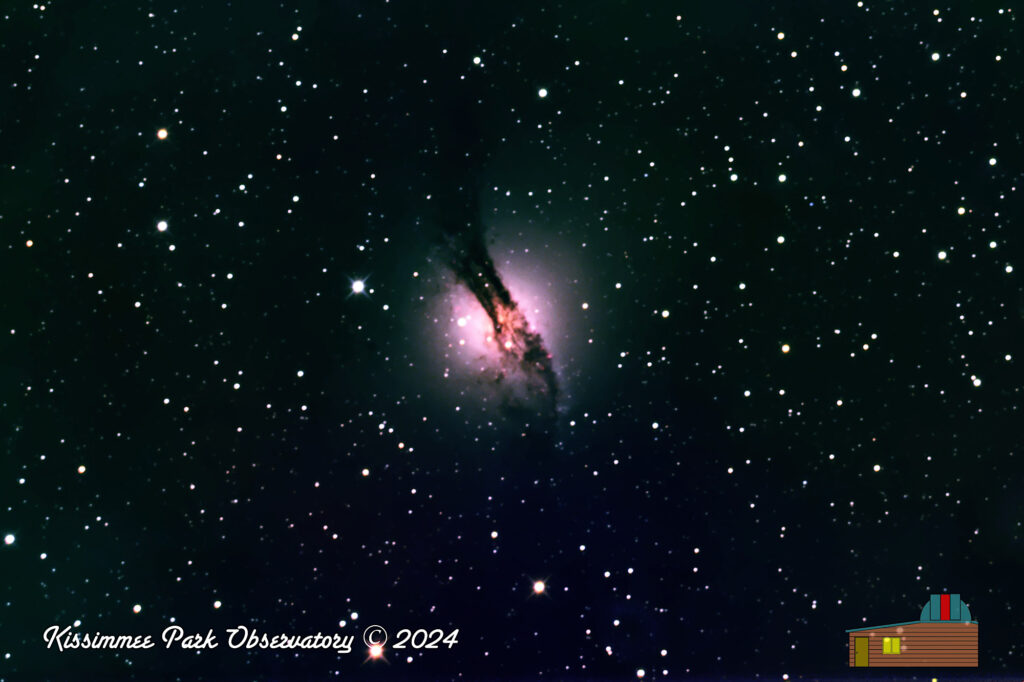
The galaxy Centaurus A (NGC 5128), as captured by the RC-12 Astrograph in the KPO dome. HaLRGB image with a total integration time of 8.5 hours.
Centaurus A, also known as NGC 5128, is a remarkable galaxy that stands out as one of the most intriguing and well-studied objects in the night sky. Located in the constellation of Centaurus, approximately 12 million light-years away from Earth, Centaurus A is a giant elliptical galaxy with a fascinating history and a wealth of unique characteristics that have captured the attention of astronomers for decades.
One of the most striking features of Centaurus A is its peculiar appearance, which is the result of a rare cosmic collision between two galaxies. This collision, which likely occurred hundreds of millions of years ago, has left Centaurus A with a distinctive shape characterized by a bright central core surrounded by a dark band of dust and gas. This dust lane is thought to be the remnant of one of the original galaxies involved in the collision, which has since merged with the other to form the galaxy we see today.
At the heart of Centaurus A lies a supermassive black hole with a mass equivalent to about 55 million times that of our Sun. This black hole is actively accreting matter from its surroundings, producing powerful jets of high-energy particles that extend for thousands of light-years into space. These jets emit radiation across the electromagnetic spectrum, from radio waves to X-rays, making Centaurus A a prominent source of emission in the sky and a valuable target for astronomers studying the physics of black holes and active galactic nuclei.
In addition to its active nucleus, Centaurus A is also home to a population of globular clusters – dense, spherical collections of stars that orbit the galaxy. These globular clusters provide valuable insights into the formation and evolution of galaxies, as their properties can reveal important information about the age, composition, and dynamics of the galaxy in which they reside.
Centaurus A’s proximity to Earth and its unique characteristics make it a popular target for both professional astronomers and amateur stargazers. Observations of this galaxy across different wavelengths of light have yielded valuable insights into the processes that drive galaxy evolution, the behavior of black holes, and the nature of cosmic collisions.
In conclusion, Centaurus A is a fascinating and enigmatic galaxy that continues to intrigue and inspire scientists and enthusiasts alike. Its complex history, striking appearance, and active nucleus make it a treasure trove of scientific discovery and a testament to the dynamic and ever-changing nature of the universe in which we live.
Tap on the image to view a larger version.
Image Info
- Imaged from the Kissimmee Park Observatory, in Saint Cloud, Florida
- Camera : ZWO ASI2600MM Pro
- Scope: Orion RC-12 Ritchey-Chretien Astrograph, 2450mm fl, F/8
- Mount: iOptron CEM-120
- Luminance: 50 subframes of 300s = 250 min integration
- Red: 19 subframes of 300s = 95 min integration
- Green: 15 subframes of 300s = 75 min integration
- Blue: 6 subframes of 300s = 30 min integration
- Hydrogen Alpha: 12 subframes of 300s = 60 min integration
- Total integration time: 510 min = 8.5 hours.
- Captured via ASIAir Pro automation
- Optical tracking via ASIAir automation via the ASI174mm Pro guide camera
- Separate channels stacked and SHO4 integrated in Astro Pixel Processor
- Image run through Super DeNoising
- Final processing in Aperture
